Docosahexaenoic acid-derived neuroprotectin D1 induces neuronal survival via secretase- and PPARγ-mediated mechanisms in Alzheimer's disease models
- PMID: 21246057
- PMCID: PMC3016440
- DOI: 10.1371/journal.pone.0015816
Docosahexaenoic acid-derived neuroprotectin D1 induces neuronal survival via secretase- and PPARγ-mediated mechanisms in Alzheimer's disease models
Abstract
Neuroprotectin D1 (NPD1) is a stereoselective mediator derived from the omega-3 essential fatty acid docosahexaenoic acid (DHA) with potent inflammatory resolving and neuroprotective bioactivity. NPD1 reduces Aβ42 peptide release from aging human brain cells and is severely depleted in Alzheimer's disease (AD) brain. Here we further characterize the mechanism of NPD1's neurogenic actions using 3xTg-AD mouse models and human neuronal-glial (HNG) cells in primary culture, either challenged with Aβ42 oligomeric peptide, or transfected with beta amyloid precursor protein (βAPP)(sw) (Swedish double mutation APP695(sw), K595N-M596L). We also show that NPD1 downregulates Aβ42-triggered expression of the pro-inflammatory enzyme cyclooxygenase-2 (COX-2) and of B-94 (a TNF-α-inducible pro-inflammatory element) and apoptosis in HNG cells. Moreover, NPD1 suppresses Aβ42 peptide shedding by down-regulating β-secretase-1 (BACE1) while activating the α-secretase ADAM10 and up-regulating sAPPα, thus shifting the cleavage of βAPP holoenzyme from an amyloidogenic into the non-amyloidogenic pathway. Use of the thiazolidinedione peroxisome proliferator-activated receptor gamma (PPARγ) agonist rosiglitazone, the irreversible PPARγ antagonist GW9662, and overexpressing PPARγ suggests that the NPD1-mediated down-regulation of BACE1 and Aβ42 peptide release is PPARγ-dependent. In conclusion, NPD1 bioactivity potently down regulates inflammatory signaling, amyloidogenic APP cleavage and apoptosis, underscoring the potential of this lipid mediator to rescue human brain cells in early stages of neurodegenerations.
Conflict of interest statement
Figures


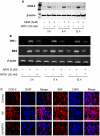

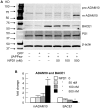
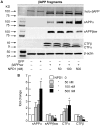
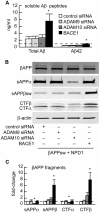
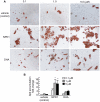
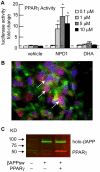


Similar articles
-
Neuroprotectin D1 induces neuronal survival and downregulation of amyloidogenic processing in Alzheimer's disease cellular models.Mol Neurobiol. 2011 Apr;43(2):131-8. doi: 10.1007/s12035-011-8174-4. Epub 2011 Mar 10. Mol Neurobiol. 2011. PMID: 21431475 Review.
-
Ginsenoside Rg1 attenuates β-amyloid generation via suppressing PPARγ-regulated BACE1 activity in N2a-APP695 cells.Eur J Pharmacol. 2012 Jan 30;675(1-3):15-21. doi: 10.1016/j.ejphar.2011.11.039. Epub 2011 Dec 7. Eur J Pharmacol. 2012. PMID: 22166376
-
Ginsenoside Re reduces Aβ production by activating PPARγ to inhibit BACE1 in N2a/APP695 cells.Eur J Pharmacol. 2016 Dec 15;793:101-108. doi: 10.1016/j.ejphar.2016.11.006. Epub 2016 Nov 10. Eur J Pharmacol. 2016. PMID: 27840193
-
Cellular and molecular events mediated by docosahexaenoic acid-derived neuroprotectin D1 signaling in photoreceptor cell survival and brain protection.Prostaglandins Leukot Essent Fatty Acids. 2009 Aug-Sep;81(2-3):205-11. doi: 10.1016/j.plefa.2009.05.024. Epub 2009 Jun 11. Prostaglandins Leukot Essent Fatty Acids. 2009. PMID: 19520558 Free PMC article. Review.
-
NPD1 Enhances Autophagy and Reduces Hyperphosphorylated Tau and Amyloid-β42 by Inhibiting GSK3β Activation in N2a/APP695swe Cells.J Alzheimers Dis. 2021;84(2):869-881. doi: 10.3233/JAD-210729. J Alzheimers Dis. 2021. PMID: 34602482
Cited by
-
Docosanoids and elovanoids from omega-3 fatty acids are pro-homeostatic modulators of inflammatory responses, cell damage and neuroprotection.Mol Aspects Med. 2018 Dec;64:18-33. doi: 10.1016/j.mam.2018.09.003. Epub 2018 Oct 1. Mol Aspects Med. 2018. PMID: 30244005 Free PMC article. Review.
-
Specialized Pro-Resolving Mediators in Neuroinflammation: Overview of Studies and Perspectives of Clinical Applications.Molecules. 2022 Jul 28;27(15):4836. doi: 10.3390/molecules27154836. Molecules. 2022. PMID: 35956787 Free PMC article. Review.
-
Pro-resolving lipid mediator reduces amyloid-β42-induced gene expression in human monocyte-derived microglia.Neural Regen Res. 2025 Mar 1;20(3):873-886. doi: 10.4103/NRR.NRR-D-23-01688. Epub 2024 May 17. Neural Regen Res. 2025. PMID: 38886959 Free PMC article.
-
PPARγ and the Innate Immune System Mediate the Resolution of Inflammation.PPAR Res. 2015;2015:549691. doi: 10.1155/2015/549691. Epub 2015 Dec 2. PPAR Res. 2015. PMID: 26713087 Free PMC article. Review.
-
Assessment of DHA on reducing early preterm birth: the ADORE randomized controlled trial protocol.BMC Pregnancy Childbirth. 2017 Feb 13;17(1):62. doi: 10.1186/s12884-017-1244-5. BMC Pregnancy Childbirth. 2017. PMID: 28193189 Free PMC article. Clinical Trial.
References
-
- Haass C, Selkoe DJ. Soluble protein oligomers in neurodegeneration: lessons from the Alzheimer's amyloid beta-peptide. Nat Rev Mol Cell Biol. 2007;8:101–112. - PubMed
-
- Golde TE, Dickson D, Hutton M. Filling the gaps in the abeta cascade hypothesis of Alzheimer's disease. Curr Alzheimer Res. 2006;3:421–430. - PubMed
-
- Bertram L, Lill CM, Tanzi RE. The genetics of Alzheimer disease: back to the future. Neuron. 2010;68:270–281. - PubMed
-
- Goedert M, Clavaguera F, Tolnay M. The propagation of prion-like protein inclusions in neurodegenerative diseases. Trends Neurosci. 2010;33:317–325. - PubMed
-
- Haass C. Initiation and propagation of neurodegeneration. Nat Med. 2010;16:1201–1204. - PubMed
Publication types
MeSH terms
Substances
Grants and funding
LinkOut - more resources
Full Text Sources
Medical
Research Materials
Miscellaneous

